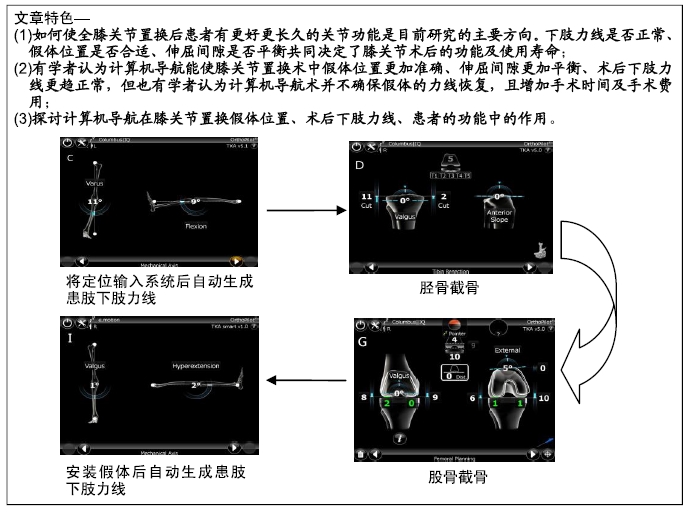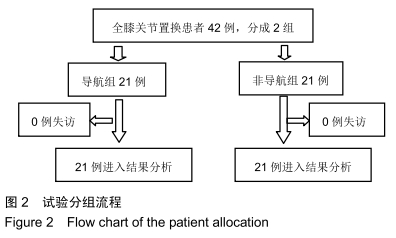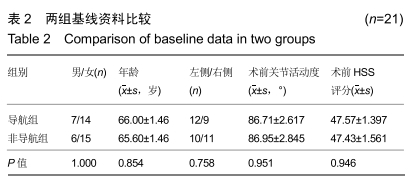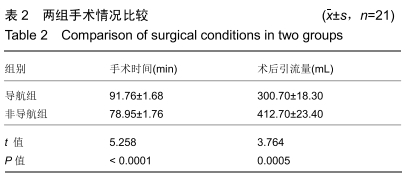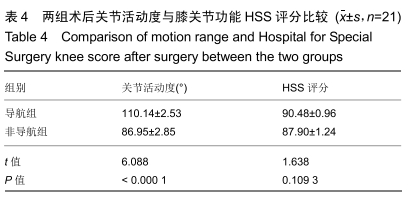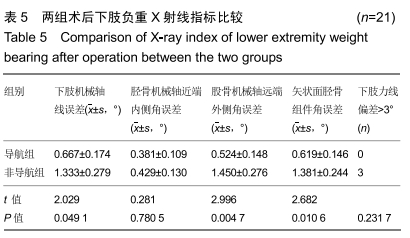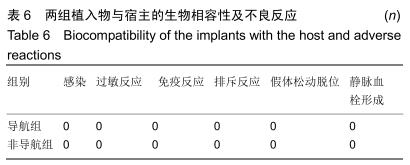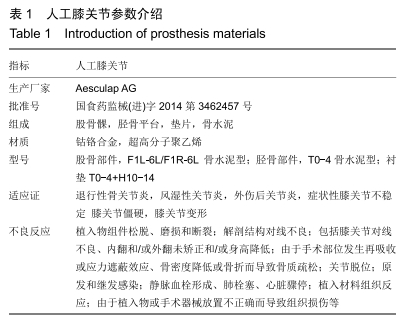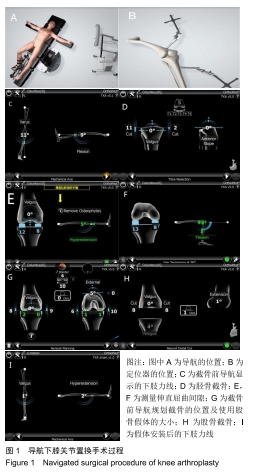[1] MC CALDEN RW, ROBERT CE, HOWARD JL, et al.Comparison of outcomes and survivorship between patients age groups following TKA.J Arthroplasty.2013;28(8 Suppl):83-86.
[2] TJOUMAKARIS FP, TUCKER BC, POST Z, et al. Arthroscopic lysis of adhesions for the stiff total knee;results after failed manipulation. Orthopedics,2014;37(5):e482-e487.
[3] FENG B, WENG X, LIN J, et al. Long-term follow-up of cemented fixed-bearing total knee arthroplasty in a Chinese population: a survival analysis of more than 10 years.J Arthroplasty. 2013;28(10): 1701-1706.
[4] TILBURY C, HAANSTRA T M, LEICHTENBERG CS, et al. Unfulfilled Expectations After Total Hip and Knee Arthroplasty Surgery:There Is a Need for Better Preoperative Patient Information and Education.J Arthroplasty.2016;31(10):2139-2145
[5] KIM HJ, LEE HJ, SHIN JY, et al. Preoperative planning using the picture archiving and communication system technique in high tibial osteotomy.J orthop Surg(Hong Kong).2017;25(1):391-397.
[6] EZZET KA, HERMIDA JC, STEKLOV N, et al. Wear of polyethylene against oxidized Zirconium femoral components effect of aggressive kinematic conditions and malalignment in total.J Arthroplasty. 2012; 27(1):116-121.
[7] CHENG T, ZHAO S, PENG X, et al. Does computer-assisted surgery improve postoperative leg alignment and implant positioning followinging total knee arthroplaty? A meat-analysis of randomized controlled trials?Knee Surg Sports Traumatol Arthrosc. 2012;20(7): 1307-1322
[8] CHOONG PF, DOWSEY MM, STONEY JD. Does accurate anatomical alignment result in better function and quality of Life? Comparing conventional and computer-assisted total knee arthroplasty.J Arthroplasty. 2009;24(4):560-569.
[9] SIKORSKI JM. Alignment in total knee replacement.J Bone Joint Surg Br.2008;90(9):1121-1127.
[10] SCHMIDT C, LILJENQVIST U, LERNER T, et al. Sagittal balance of thoracic lordoscoliosis: anterior dual rod instrumentation versus posterior pedicle screw fixation.Eur Spine J.2011;20(7):1118.
[11] TASHIRO Y, UEMURE M, MATSUDA S, et al. Articular cartilage of the posterior condyle can a ect rotational alignment in total knee arthroplasty.knee Surg Sports Traumatol Arthrosc. 2012;20(8): 1463-1469.
[12] NIKI Y, MATSUMOTO H, HAKOZAKI A, et al. Rheumatoid arthritis:a risk factor for deep venous thrombosis after total knee arthroplasty Comparative study with osteoarthritis.J Orthop Sci.2010;15(1):57-63.
[13] FU Y, WANG M, LIU Y, et al. Alignm ent outcomes in navigated total knee arthroplasty: a meta-analysis.Knee Surg Sports Traumatol Arthrosc. 2012;20(6):1075-1082.
[14] MOLI RG, ANDERSON KC, BUEHLER KC, et al. Computer assisted navigation software advancements improve the accuracy of total knee arthroplasty.J Arthroplasty. 2011;26(3):432-438.
[15] SIM JA, LEE YS, KWAK JH, et al. Comparison of complete distal release of the medial collateral ligament and medial epicondylar osteotomy during ligament balancing in varus knee total arthroplasty. Clin Orthop Surg.2013;5(4):Ca287-291.
[16] CLARK G, LEONG A, MCEWEN P, et al. Itra-operative reliability of Shape Match cutting guide placement in total knee arthroplasty. Comput Aided Surg.2013;18(5-6):159-165.
[17] NAKANO N,MATSUMOTO T,ISHIDA K,et al.Long-term subjective outcomes of computer-assisted tatal knee arthroplaty.Int Orthop. 2013;37(10):1911-1915.
[18] RAHM S, CAMENZIND RS, HINGSAMMER A, et al. Postoperative alignment of TKA in patients with severe preoperative varus or valgus deformity:is there a difference between surgical techniques?BMC Musculoskelet Disord.2017;18(1):272-275.
[19] 陈拥,王增辉,朴成哲.3D打印个性化截骨导板辅助行全膝关节置换的应用[J].中国组织工程研究,2019,23(8):1155-1160.
[20] MATTEI L, PELLEGRINO P, CALO M, et al. Patient specific instrumentation in total knee arthroplasty:a state of the art.Ann Transl Med.2016;4(7):126.DOI10.21037/atm.2016.03.33
[21] 吴德胜,邓仲豪,陈宇皤,等.便携式导航辅助全膝关节置换术的初步临床疗效[J].中华骨科杂志,2018,38(17):1036-1044.
[22] KIM YH, KIM JS, YOON SH. Alignment and orientation of the components in total knee replacement with and without navigation support: a prospective,randomised study.J Bone Joint Surg Br. 2007; 89(4):471-476
[23] 张永站.计算机导航辅助全膝关节置换定位与软组织平衡[J].中国组织工程研究,2016,20(9):1302-1308.
[24] GOH GS, LIOW MHL, TAY DK, et al. Accelerometer-Based and Computer-Assisted Navigation in tatal Knee Arthroplasty:A Reduction in Mechanical Axis Outliers Does Not Lead to Improvement in Functional Outcomes or Quality of life When Comparded to Conventional Total Knee Arthroplasty.J Arthroplasty. 2018;33(2):379-385.
[25] BAUWENS K, MATTHES G, WICH M, et al.Navigated total knee replacement. A meta-analysis.J Bone Joint Surg Am. 2007;89(2): 261-269.
[26] FERGUSON KB, BAILEY O, ANTHONY I, et al. A comparison of lateral release rates in fixed-versus mobile-bearing total knee arthroplasty. J Orthop Traumatol.2015;16(2):87-90.
[27] REBAL BA, BABATUNDE OM, LEE JH, et al. Imageless computer navigation in total knee arthroplasty provides superior short term functional outcomes:a meta-analysis.J Arthroplasty. 2014;29(5): 938-944.
[28] JEFFERY RS, MORRIS RW, DENHAM RA. Coronal alignment after total knee replacement. J Bone Joint Surg Br.1991;73(5):709-714.
[29] HISCOX CM, BOHM ER, TURGEON TR, et al. Randomized trial of computer-assisted knee arthroplasty:impact on clinical and radiographic outcomes.J Arthroplasty.2011;26(8):1259-1264.
[30] MULLAJI A, KANNA R, MARAWAR S, et al. Comparison of limb and component alignment using computer-assisted navigation versus image intensifier-guided conventional total knee arthroplasty:a prospective,randomized,single-surgeon study of 467 knees.J Arthroplasty. 2007;22(7):953-959.
[31] GOTHESEN O, ESPEHAUG B, HAVELIN LI, et al. Functional outcome and alignment in computer-assisted and conventionally operated total knee replacements: a multicentre parallel-group randomised controlled trial.Bone Joint J.2014;96-B(5):609-618.
[32] BARRETT W HOEFFEL D, DALURY D, et al. In-vivo alignment comparing patient specific instrumentation with both conventional and computer assisted surgery (CAS) instrumentation in total knee arthroplat. J Arthroplasty.2014;29(2):343-347.
[33] HISCOX CM, BOHM ER, TURGEON TR, et al. Randomized trial of computer-assisted knee arthroplasty:impact on clinical and radiographic outcome.J Arthroplasty.2011;26(8):1259-1264
[34] MARTIN A, SHEIN KOP MB, LANGHENRY MM, et al. Accuracy of side-cutting implantation instruments for total knee arthroplasty].Knee Surg Sports Traumatol Arthrosc.2009;17(4):374-381.
[35] MATZIOLIS G, KROCKER D, WEISS U, et al. A prospective, randomized study of computer-assisted and conventional total kneearthroplasty.Three-dimensional evaluation of implant alignment and rotation.J Bone Joint Surg Am.2007;89(2):236-243.
[36] ZHANG Z, GU B, ZHU W, et al. Minimal invasive and computer- assisted total knee replacement compared with the minimal invasive technique:a prospective, randomized trial with short-term outcomes. Arch Orthop Trauma Surg.2014;134(1):65-71.
[37] THIENGWITTAYAPORN S, KANJANAPIBOONWONG A, JUNSEE D. Midterm outcomes of electromagnetic computer-assisted navigation in minimally invasive total knee arthroplasty.J Orthop Surg Res. 2013; 8(1):37-43.
[38] 程国芳,何宝林,王小伟,等.计算机导航辅助与传统手术行人工膝关节置换的疗效比较[J].临床骨科杂志,2018,21(5):558-561.
[39] PANG HN, YEO SJ, CHONG HC, et al. Computer-assisted gap balancing technique improves outcome in total knee arthroplasty, compared with conventional measured resection technique.Knee Surg Sports Traumatol Arthrosc. 2011;19(9):1496-1503.
[40] 徐志宏,陈东阳,史冬泉,等.计算机导航下与传统人工全膝关节置换术的疗效比较[J].中国修复重建外科杂志,2014,28(9):1066-1071.
|
